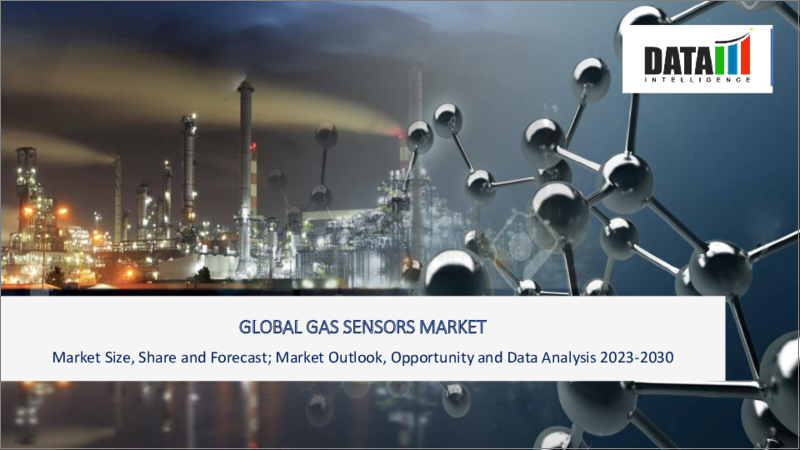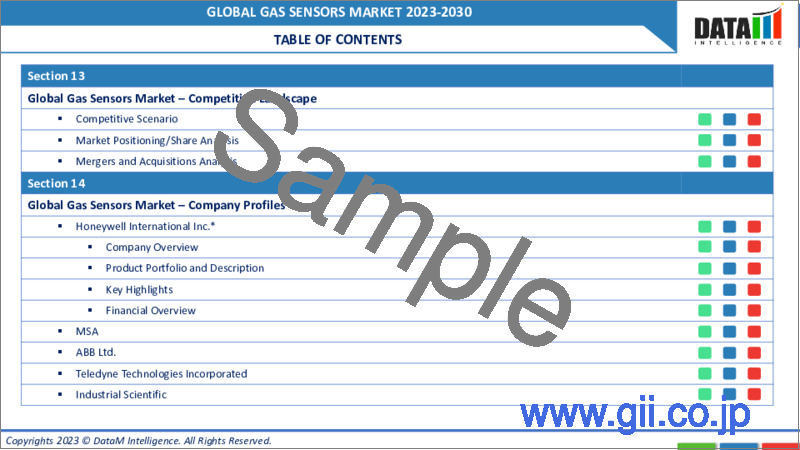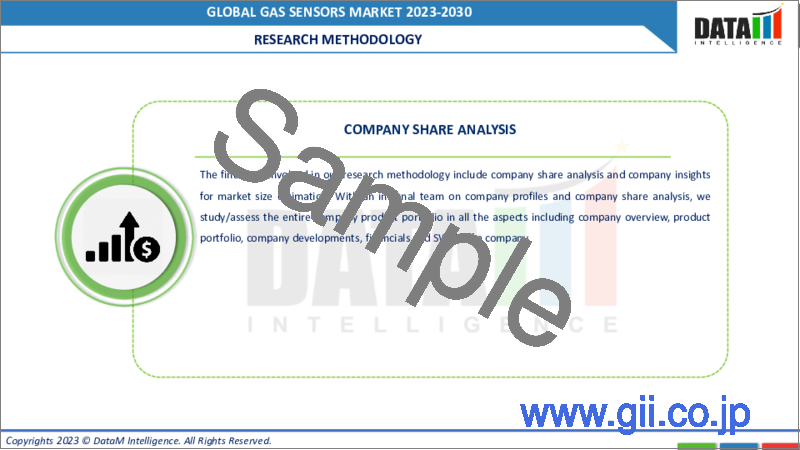|
|
市場調査レポート
商品コード
1208700
ガスセンサの世界市場-2022-2029Global Gas Sensors Market - 2022-2029 |
||||||
|
● お客様のご希望に応じて、既存データの加工や未掲載情報(例:国別セグメント)の追加などの対応が可能です。 詳細はお問い合わせください。 |
|||||||
| ガスセンサの世界市場-2022-2029 |
|
出版日: 2023年02月01日
発行: DataM Intelligence
ページ情報: 英文 210 Pages
納期: 約2営業日
|
- 全表示
- 概要
- 目次
市場の概要
ガスセンサの世界市場は、予測期間2022-2029年のCAGRは5.9%で成長すると予測されています。
ガスセンサーは、価電子帯正孔、伝導帯電子または励起子の動きを3つの空間方向すべてに閉じ込める半導体ナノ構造です。ガスセンサーの特性は、その形状や材料によって異なります。量子力学により、ガスセンサーは大きな粒子とは異なる光学的および電子的特性を示します。ガスセンサーは、単電子トランジスタ、太陽電池、LED、レーザー、単一光子源、第二高調波発生、量子コンピューティング、医療用画像処理などに広く使用されています。
市場力学
様々な産業でガスセンサの採用が進んでいることが、世界市場の主な促進要因となっています
ガスセンサは、安全性を高めるために、さまざまな産業で採用が進んでいます。例えば、医療・ヘルスケア分野では、短期的・長期的に健康に悪影響を及ぼす可能性のある(揮発性有機化合物)VOCの測定に、主にセンサー技術が使用されています。さらに、ガスセンサーは、体内の有毒ガスを分析するために、患者監視システムなどの医療機器にも組み込まれています。
ガスセンサーの寿命は短いため、世界市場の抑制要因になると考えられています
一般的なガスセンサーの設計には、複数の電気・電子パラメータが使用されています。そのため、ガスセンサは高度になりますが、その分寿命が短くなります。センサーの寿命が短いのは、温度、湿度、干渉ガス、振動や衝撃などの物理的要因やセンサーへの汚染や損傷など、一般的な電気化学ガスセンサーが置かれる様々な要因に起因します。予測期間中、世界市場の成長を妨げる重要な要因となるでしょう。
新しい政府のイニシアチブは、ガスセンサーの世界市場に新たな機会を生み出すと予想されます
様々な国の政府は、産業プロセスにおけるガス排出を制御することで地球温暖化を抑制することに焦点を当てた、新しい環境政策やプロトコルを導入する傾向にあります。これらの取り組みにより、産業プラントにおける有毒ガスや可燃性ガスのモニタリングや検出を支援する、製造分野におけるガス検出システムの需要をエスカレートさせる新たなフレームワークが構築されるでしょう。また、狭い場所での酸素濃度の測定や、工業用高炉での燃焼の制御も支援します。政府の新たな取り組みにより、予測期間中に世界市場に新たな機会が生まれるでしょう。
新しいガスセンサーの開発のための長いリードタイムは、世界市場に課題をもたらすと予想されます
新しいタイプのガスセンサーの開発は、複数のパラメータに取り組む複雑なプロセスです。新しいガスセンサーの調査、設計、開発、プロトタイピング、フィールドテストには長いリードタイムが必要であり、世界のガスセンサー市場の成長にとって大きな課題となっています。
COVID-19の影響分析
COVID-19の大流行は、世界のガスセンサ市場に大きな影響を与えました。パンデミックは、新しいセンサーのフィールドテストを含む研究開発活動を妨げました。また、パンデミックの経済的な不確実性によってもたらされた資本支出の削減により、様々なエンドユーザーからの需要も大幅に減少しました。さらに、COVID-19の大流行によるサプライチェーンの制約により、多くの主要部品が不足し、ガスセンサーの製造に支障をきたしています。現在進行中の様々な課題にもかかわらず、パンデミックは世界のガスセンサ市場の長期的な成長に影響を与えないと予想され
業界における最近の動向:
1.2022年7月、米国ペンシルベニア州立大学と中国河北工業大学の研究チームが、レーザー誘起グラフェンから耐湿性の伸縮性ガスセンサーを開発しました
2.2022年7月、英国ケンブリッジ大学の研究チームが、NO2ガスセンサーを内蔵した洗濯可能なナイロンベースの布を開発
目次
第1章 ガスセンサの世界市場の調査手法と範囲
- 調査手法
- 調査目的・調査範囲
第2章 ガスセンサーの世界市場-市場の定義と概要
第3章 ガスセンサの世界市場- エグゼクティブサマリー
- タイプ別市場内訳
- ガス別市場内訳
- 接続性別の市場内訳
- エンドユーザー別市場内訳
- 地域別市場内訳
第4章 ガスセンサの世界市場-市場力学
- 市場影響要因
- 促進要因
- 様々な産業におけるガスセンサの採用の増加
- 抑制要因
- ガスセンサの寿命の短さ
- ビジネスチャンス
- 政府の新たな取り組み
- 影響分析
- 促進要因
第5章 ガスセンサの世界市場- 産業分析
- ポーターのファイブフォース分析
- サプライチェーン分析
- 価格設定分析
- 規制分析
第6章 ガスセンサの世界市場-COVID-19分析
- COVID-19の市場分析
- COVID-19登場前の市場シナリオ
- COVID-19の現在の市場シナリオ
- COVID-19以降、または将来のシナリオ
- COVID-19の中での価格ダイナミクス
- 需給バランス
- 金属・化学品パンデミック時の市場に関する取り組み
- メーカーの戦略的取り組み
- まとめ
第7章 ガスセンサの世界市場- タイプ別
- 電気化学式
- 光電離型センサー
- 金属酸化物センサー
- 触媒式
- 赤外線センサー
- レーザー
- ジルコニア
- ホログラフィック
- その他
第8章 ガスセンサの世界市場(ガス別
- 酸素
- 一酸化炭素
- 二酸化炭素
- アンモニア
- 塩素
- 硫化水素
- 窒素酸化物
- VOC
- 炭化水素類
- メタン
- 水素
第9章 ガスセンサの世界市場- エンドユーザー別
- 石油・ガス
- 鉱業
- 医療
- 自動車・輸送機器
- 民生用電子機器
- 金属・化学品
- スマートシティ
- 廃水処理
- 飲食品・飲料
- 発電所
- その他
第10章 ガスセンサの世界市場- 接続性別
- 有線
- ワイヤレス
第11章 ガスセンサの世界市場ガスセンサーの世界市場:地域別
- 北米
- 米国
- カナダ
- メキシコ
- 欧州
- ドイツ
- 英国
- フランス
- イタリア
- スペイン
- その他欧州
- 南米
- ブラジル
- アルゼンチン
- その他の南米地域
- アジア太平洋地域
- 中国
- インド
- 日本
- オーストラリア
- その他アジア太平洋地域
- 中東・アフリカ地域
第12章 ガスセンサの世界市場- 競争情勢
- 競合シナリオ
- 市況分析/シェア分析
- M&A(合併・買収)分析
第13章 ガスセンサの世界市場ガスセンサーの世界市場- 企業プロファイル
- Honeywell International Inc.
- 企業概要
- 製品ポートフォリオと説明
- 主なハイライト
- 財務概要
- MSA
- ABB Ltd.
- Industrial Scientific
- GENERAL ELECTRIC
- Teledyne Technologies Limited
- Detector Electronics Corporation
- Emerson Electric Co
- Thermo Fisher Scientific
- Figaro Engineering Inc
第14章 ガスセンサーの世界市場- 重要考察
第15章 ガスセンサの世界市場-DataM
Market Overview
The global gas sensors market was valued at US$ XX billion in 2021; it is projected to reach US$ XX billion by 2029, with growth at a CAGR of 5.9% over the forecast period 2022-2029.
Gas sensors are the semiconductor nanostructures that confine the motion of valence band holes, conduction band electrons or excitons in all three spatial directions. The properties of the gas sensors vary as per their shape and material. Due to quantum mechanics, gas sensors exhibit optical and electronic properties that differ from larger particles. Gas sensors are widely used in single-electron transistors, solar cells, LEDs, lasers, single-photon sources, second-harmonic generation, quantum computing and medical imaging.
Market Dynamics
The increasing adoption of gas sensors in various industries is a major driver for the global market:
Gas sensors are being increasingly adopted across various industries to enhance safety. For instance, in the medical and healthcare segment, the sensor technology is primarily used for measuring (Volatile Organic Compounds) VOCs, which may have adverse short-term and long-term health effects. Moreover, gas sensors are also integrated into medical devices such as patient monitoring systems for analyzing the toxic gas in the body.
The shorter life span of gas sensors is expected to restrain the global market:
The design of typical gas sensors involves the usage of multiple electric and electronic parameters. Although it makes the gas sensor advanced, it also leads to a shorter life span. The shorter life span of the sensors is owing to the various factors through which a typical electrochemical gas sensor is put under which, including temperature, humidity, interfering gases and physical factors such as vibration and impact and contamination or damage to the sensor. It will be a key factor in preventing the growth of the global market during the forecast period.
New government initiatives are expected to generate new opportunities for the global gas sensors market:
Governments from various nations are prone to introducing new environmental policies and protocols that focus on reducing global warming by controlling gas emissions in the industrial processes. These initiatives will create new frameworks that will escalate the demand for gas detection systems in the manufacturing sector to assist in monitoring and detecting poisonous and combustible gases in industrial plants. It also aids in the measurement of oxygen levels in small places and controls combustion in industrial blast furnaces. The new government initiatives will generate new opportunities for the global market during the forecast period.
Long lead times for developing new gas sensors are expected to present challenges for the global market:
The development of new types of gas sensors is a complicated process that involves working on multiple parameters. The research, design, development, prototyping and field testing of new gas sensors requires long lead times and present major challenges for the growth of the global gas sensors market.
COVID-19 Impact Analysis
The COVID-19 pandemic majorly impacted the global gas sensors market. The pandemic hampered research and development activities, including the field testing of new sensors. Demand from various end-users also reduced significantly due to cuts in capital expenditure brought on by the economic uncertainty of the pandemic. Furthermore, supply chain constraints caused by the COVID-19 pandemic have hampered the manufacturing of gas sensors due to a shortage of many key components. Despite the various ongoing challenges, the pandemic is not expected to impact the long-term growth of the global gas sensors market and
Recent Developments in the Industry:
1. In July 2022, a team of researchers from Penn State University in U.S. and the Hebei University of Technology, China, developed a moisture-resistant stretchable gas sensor from laser-induced graphene.
2. In July 2022, a team of researchers from Cambridge University, UK, developed a washable nylon-based fabric with integrated NO2 gas sensors.
Market Segmentation:
The scope of the report covers segmentation based on type, gas, connectivity, end-user and region. The global gas sensors market is segmented by type into electrochemical, photoionization detectors, metal-oxide sensors, catalytic, infrared, laser, zirconia, holographic and others. The global gas sensors market is segmented by gas into oxygen, carbon monoxide, carbon dioxide, ammonia, chlorine, hydrogen sulfide, nitrogen oxides, VOCs, hydrocarbons, methane and hydrogen. The global gas sensors market is segmented by connectivity into wired and wireless. The global gas sensors market is segmented by end-user into oil and gas, mining, medical, automotive and transportation, consumer electronics, metals and chemicals, smart cities, wastewater treatment, food and beverages, power stations and others. The global gas sensors market is segmented by region into North America, South America, Europe, Asia-Pacific, Middle East and Africa.
1. Wired: Wired gas sensors are more reliable and faster than wireless gas sensors since wires physically connect sensors to the base unit. Owing to high reliability, wired gas sensors are widely accepted in industries such as oil and gas, industrial applications, the defense industry, food and beverages, mining and others.
2. Wireless: Wireless gas sensors are becoming common globally owing to lower installation and maintenance costs. Moreover, wireless gas sensor network allows a greater level of flexibility.
Regional Classification:
According to the DataM Intelligence market research report, the global Gas sensors market is divided into North America, South America, Europe, Asia-Pacific, Middle East and Africa.
In particular, due to air pollution, U.S. has witnessed extensive use of gas sensors for indoor and outdoor air quality. Gas sensors are also widely used in industrial areas for oxygen detection, toxic gas monitoring, flammable gas detection and duct monitoring, among other applications. The growing demand for air quality monitoring in homes and other residential and commercial spaces is the primary factor driving the growth of the North American gas sensors market during the forecast period.
The regulatory environment surrounding the gas sensors market is stringent in Europe, with several product testing and certification requirements. Gas sensors, detectors and other monitoring equipment of gases intended for use in potentially explosive environments must be tested and marked under ATEX (Atmosphere Explosible) directive. Germany, UK and France are the leading countries in Europe for adopting gas sensors. Regulation mandating the use of gas sensors in various industries will be a major factor in driving the growth of the European gas sensors market.
Automotive and transportation is the major end-user of gas sensors in the Asia-Pacific, with large automotive production in China, India and Japan. Oil and gas is another key industry for using gas sensors in the region, with large industries in countries such as China, India and Indonesia. The demand for gas sensors surged with increased interest in gas detection and stringent safety legislation. Due to growing demand from many key industries, the Asia-Pacific gas sensors market will likely witness sustained growth in the coming years.
Competitive Analysis:
The global gas sensors market is consolidated, with major international players having the largest market share. The companies compete within the market by launching new products, expanding to new territories, acquiring new startups in the sector and collaborating with other major market players.
Major Companies:
Some key companies contributing to the global gas sensors market growth include Honeywell International Inc., ABB, MSA, Teledyne Technologies Incorporated, Industrial Scientific, General Electric, Detector Electronics Corporation, Emerson Electric Co, SICK AG, Thermo Fisher Scientific and Figaro Engineering Inc, among others.
The Full Report has the below insights.
- The report offers a comprehensive evaluation of the market in terms of Market Value (US$) and Y-o-Y Growth Rates (%). It does so via in-depth qualitative insights, historical data (2020-2021) and verifiable projections about market size during the forecast period (2022-2029).
- Visualize the composition of the global Gas sensors market segmentation by drone type, application and region, highlighting the key commercial assets and players.
By Type: Electrochemical, Photoionization Detectors, Metal-Oxide Sensors, Catalytic, Infrared, Laser, Zirconia, Holographic and Others
By Gas: Oxygen, Carbon Monoxide, Carbon Dioxide, Ammonia, Chlorine, Hydrogen Sulfide, Nitrogen Oxides, VOCs, Hydrocarbons, Methane and Hydrogen
By Connectivity: Wired and Wireless
By End-User: Oil And Gas, Mining, Medical, Automotive And Transportation, Consumer Electronics, Metals And Chemicals, Smart Cities, Wastewater Treatment, Food And Beverages, Power Stations And Others
By Region: North America, South America, Europe, Asia-Pacific, Middle East and Africa
- Identify commercial opportunities in the global Gas sensors market by analyzing trends and co-development deals.
- The report also covers data insights on various industry forces such as porter's five forces, regulations in each country, reimbursement scenario, technological advancements, PEST analysis and pricing analysis.
- Excel data sheet with thousands of global Gas sensors market-level 4/5 segmentation data points.
- PDF report with the most relevant analysis cogently put together after exhaustive qualitative interviews and in-depth market study.
- Product mapping in excel for the key product of all major market players
The global gas sensors market report would provide access to an approx. 69 market data table, 83 figures and 210 pages.
Table of Contents
1. Global Gas Sensors Market Methodology and Scope
- 1.1. Research Methodology
- 1.2. Research Objective and Scope of the Report
2. Global Gas Sensors Market - Market Definition and Overview
3. Global Gas Sensors Market - Executive Summary
- 3.1. Market Snippet By Type
- 3.2. Market Snippet By Gas
- 3.3. Market Snippet By Connectivity
- 3.4. Market Snippet By End-User
- 3.5. Market Snippet By Region
4. Global Gas Sensors Market-Market Dynamics
- 4.1. Market Impacting Factors
- 4.1.1. Drivers
- 4.1.1.1. The increasing adoption of gas sensors in various industries
- 4.1.1.2. XX
- 4.1.2. Restraints
- 4.1.2.1. The shorter life span of gas sensors
- 4.1.2.2. XX
- 4.1.3. Opportunity
- 4.1.3.1. New government initiatives
- 4.1.4. Impact Analysis
- 4.1.1. Drivers
5. Global Gas Sensors Market - Industry Analysis
- 5.1. Porter's Five Forces Analysis
- 5.2. Supply Chain Analysis
- 5.3. Pricing Analysis
- 5.4. Regulatory Analysis
6. Global Gas Sensors Market - COVID-19 Analysis
- 6.1. Analysis of COVID-19 on the Market
- 6.1.1. Before COVID-19 Market Scenario
- 6.1.2. Present COVID-19 Market Scenario
- 6.1.3. After COVID-19 or Future Scenario
- 6.2. Pricing Dynamics Amid COVID-19
- 6.3. Demand-Supply Spectrum
- 6.4. Metals and Chemicals Initiatives Related to the Market During Pandemic
- 6.5. Manufacturers Strategic Initiatives
- 6.6. Conclusion
7. Global Gas Sensors Market - By Type
- 7.1. Introduction
- 7.1.1. Market Size Analysis and Y-o-Y Growth Analysis (%), By Type
- 7.1.2. Market Attractiveness Index, By Type
- 7.2. Electrochemical*
- 7.2.1. Introduction
- 7.2.2. Market Size Analysis and Y-o-Y Growth Analysis (%)
- 7.3. Photoionization Detectors
- 7.4. Metal-Oxide Sensors
- 7.5. Catalytic
- 7.6. Infrared
- 7.7. Laser
- 7.8. Zirconia
- 7.9. Holographic
- 7.10. Others
8. Global Gas Sensors Market - By Gas
- 8.1. Introduction
- 8.1.1. Market Size Analysis and Y-o-Y Growth Analysis (%), By Gas
- 8.1.2. Market Attractiveness Index, By Gas
- 8.2. Oxygen*
- 8.2.1. Introduction
- 8.2.2. Market Size Analysis and Y-o-Y Growth Analysis (%)
- 8.3. Carbon Monoxide
- 8.4. Carbon Dioxide
- 8.5. Ammonia
- 8.6. Chlorine
- 8.7. Hydrogen Sulfide
- 8.8. Nitrogen Oxides
- 8.9. VOCs
- 8.10. Hydrocarbons
- 8.11. Methane
- 8.12. Hydrogen
9. Global Gas Sensors Market - By End-User
- 9.1. Introduction
- 9.1.1. Market Size Analysis and Y-o-Y Growth Analysis (%), By End-User
- 9.1.2. Market Attractiveness Index, By End-User
- 9.2. Oil And gas*
- 9.2.1. Introduction
- 9.2.2. Market Size Analysis and Y-o-Y Growth Analysis (%)
- 9.3. Mining
- 9.4. Medical
- 9.5. Automotive and Transportation
- 9.6. Consumer Electronics
- 9.7. Metals and Chemicals
- 9.8. Smart Cities
- 9.9. Wastewater Treatment
- 9.10. Food And Beverages
- 9.11. Power Stations
- 9.12. Others
10. Global Gas Sensors Market - By Connectivity
- 10.1. Introduction
- 10.1.1. Market Size Analysis and Y-o-Y Growth Analysis (%), By Connectivity
- 10.1.2. Market Attractiveness Index, By Connectivity
- 10.2. Wired*
- 10.2.1. Introduction
- 10.2.2. Market Size Analysis and Y-o-Y Growth Analysis (%)
- 10.3. Wireless
11. Global Gas Sensors Market - By Region
- 11.1. Introduction
- 11.2. Market Size Analysis and Y-o-Y Growth Analysis (%), By Region
- 11.3. Market Attractiveness Index, By Region
- 11.4. North America
- 11.4.1. Introduction
- 11.4.2. Key Region-Specific Dynamics
- 11.4.3. Market Size Analysis and Y-o-Y Growth Analysis (%), By Type
- 11.4.4. Market Size Analysis and Y-o-Y Growth Analysis (%), By Gas
- 11.4.5. Market Size Analysis and Y-o-Y Growth Analysis (%), By Connectivity
- 11.4.6. Market Size Analysis and Y-o-Y Growth Analysis (%), By End-User
- 11.4.7. Market Size Analysis and Y-o-Y Growth Analysis (%), By Country
- 11.4.7.1. U.S.
- 11.4.7.2. Canada
- 11.4.7.3. Mexico
- 11.5. Europe
- 11.5.1. Introduction
- 11.5.2. Key Region-Specific Dynamics
- 11.5.3. Market Size Analysis and Y-o-Y Growth Analysis (%), By Type
- 11.5.4. Market Size Analysis and Y-o-Y Growth Analysis (%), By Gas
- 11.5.5. Market Size Analysis and Y-o-Y Growth Analysis (%), By Connectivity
- 11.5.6. Market Size Analysis and Y-o-Y Growth Analysis (%), By End-User
- 11.5.7. Market Size Analysis and Y-o-Y Growth Analysis (%), By Country
- 11.5.7.1. Germany
- 11.5.7.2. UK
- 11.5.7.3. France
- 11.5.7.4. Italy
- 11.5.7.5. Spain
- 11.5.7.6. Rest of Europe
- 11.6. South America
- 11.6.1. Introduction
- 11.6.2. Key Region-Specific Dynamics
- 11.6.3. Market Size Analysis and Y-o-Y Growth Analysis (%), By Type
- 11.6.4. Market Size Analysis and Y-o-Y Growth Analysis (%), By Gas
- 11.6.5. Market Size Analysis and Y-o-Y Growth Analysis (%), By Connectivity
- 11.6.6. Market Size Analysis and Y-o-Y Growth Analysis (%), By End-User
- 11.6.7. Market Size Analysis and Y-o-Y Growth Analysis (%), By Country
- 11.6.7.1. Brazil
- 11.6.7.2. Argentina
- 11.6.7.3. Rest of South America
- 11.7. Asia-Pacific
- 11.7.1. Introduction
- 11.7.2. Key Region-Specific Dynamics
- 11.7.3. Market Size Analysis and Y-o-Y Growth Analysis (%), By Type
- 11.7.4. Market Size Analysis and Y-o-Y Growth Analysis (%), By Gas
- 11.7.5. Market Size Analysis and Y-o-Y Growth Analysis (%), By Connectivity
- 11.7.6. Market Size Analysis and Y-o-Y Growth Analysis (%), By End-User
- 11.7.7. Market Size Analysis and Y-o-Y Growth Analysis (%), By Country
- 11.7.7.1. China
- 11.7.7.2. India
- 11.7.7.3. Japan
- 11.7.7.4. Australia
- 11.7.7.5. Rest of Asia-Pacific
- 11.8. Middle East and Africa
- 11.8.1. Introduction
- 11.8.2. Key Region-Specific Dynamics
- 11.8.3. Market Size Analysis and Y-o-Y Growth Analysis (%), By Type
- 11.8.4. Market Size Analysis and Y-o-Y Growth Analysis (%), By Gas
- 11.8.5. Market Size Analysis and Y-o-Y Growth Analysis (%), By Connectivity
- 11.8.6. Market Size Analysis and Y-o-Y Growth Analysis (%), By End-User
12. Global Gas Sensors Market - Competitive Landscape
- 12.1. Competitive Scenario
- 12.2. Market Positioning/Share Analysis
- 12.3. Mergers and Acquisitions Analysis
13. Global Gas Sensors Market - Company Profiles
- 13.1. Honeywell International Inc.
- 13.1.1. Company Overview
- 13.1.2. Product Portfolio and Description
- 13.1.3. Key Highlights
- 13.1.4. Financial Overview
- 13.2. MSA
- 13.3. ABB Ltd.
- 13.4. Industrial Scientific
- 13.5. GENERAL ELECTRIC
- 13.6. Teledyne Technologies Limited
- 13.7. Detector Electronics Corporation
- 13.8. Emerson Electric Co
- 13.9. Thermo Fisher Scientific
- 13.10. Figaro Engineering Inc
LIST NOT EXHAUSTIVE
14. Global Gas Sensors Market - Premium Insights
15. Global Gas Sensors Market - DataM
- 15.1. Appendix
- 15.2. About Us and Photoionization Detectors
- 15.3. Contact Us




